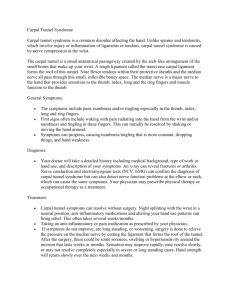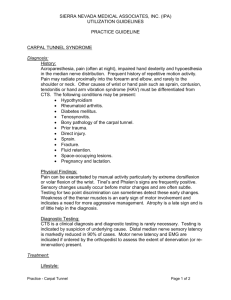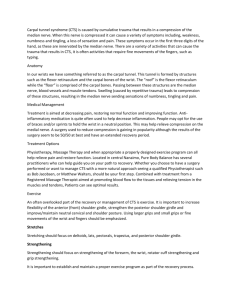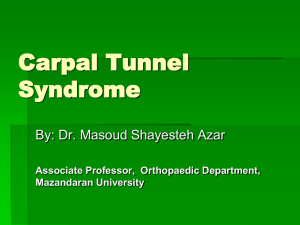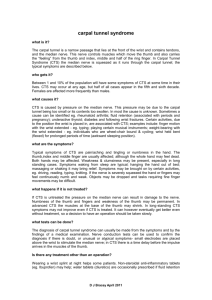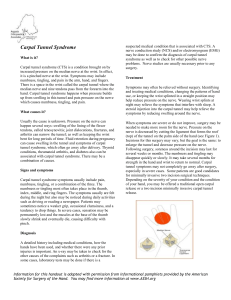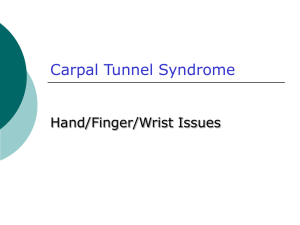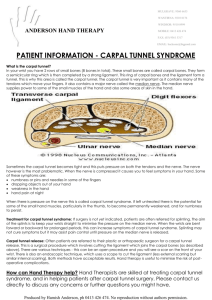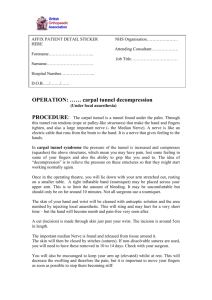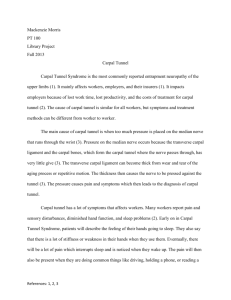Erin K. Greer, MD
advertisement
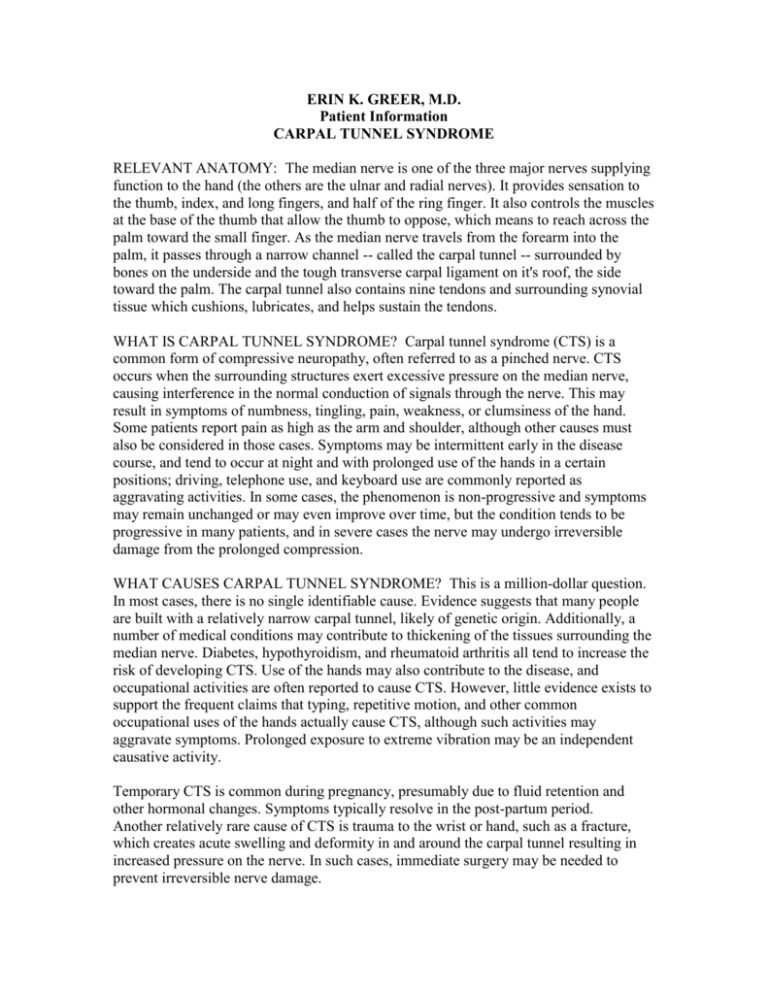
ERIN K. GREER, M.D. Patient Information CARPAL TUNNEL SYNDROME RELEVANT ANATOMY: The median nerve is one of the three major nerves supplying function to the hand (the others are the ulnar and radial nerves). It provides sensation to the thumb, index, and long fingers, and half of the ring finger. It also controls the muscles at the base of the thumb that allow the thumb to oppose, which means to reach across the palm toward the small finger. As the median nerve travels from the forearm into the palm, it passes through a narrow channel -- called the carpal tunnel -- surrounded by bones on the underside and the tough transverse carpal ligament on it's roof, the side toward the palm. The carpal tunnel also contains nine tendons and surrounding synovial tissue which cushions, lubricates, and helps sustain the tendons. WHAT IS CARPAL TUNNEL SYNDROME? Carpal tunnel syndrome (CTS) is a common form of compressive neuropathy, often referred to as a pinched nerve. CTS occurs when the surrounding structures exert excessive pressure on the median nerve, causing interference in the normal conduction of signals through the nerve. This may result in symptoms of numbness, tingling, pain, weakness, or clumsiness of the hand. Some patients report pain as high as the arm and shoulder, although other causes must also be considered in those cases. Symptoms may be intermittent early in the disease course, and tend to occur at night and with prolonged use of the hands in a certain positions; driving, telephone use, and keyboard use are commonly reported as aggravating activities. In some cases, the phenomenon is non-progressive and symptoms may remain unchanged or may even improve over time, but the condition tends to be progressive in many patients, and in severe cases the nerve may undergo irreversible damage from the prolonged compression. WHAT CAUSES CARPAL TUNNEL SYNDROME? This is a million-dollar question. In most cases, there is no single identifiable cause. Evidence suggests that many people are built with a relatively narrow carpal tunnel, likely of genetic origin. Additionally, a number of medical conditions may contribute to thickening of the tissues surrounding the median nerve. Diabetes, hypothyroidism, and rheumatoid arthritis all tend to increase the risk of developing CTS. Use of the hands may also contribute to the disease, and occupational activities are often reported to cause CTS. However, little evidence exists to support the frequent claims that typing, repetitive motion, and other common occupational uses of the hands actually cause CTS, although such activities may aggravate symptoms. Prolonged exposure to extreme vibration may be an independent causative activity. Temporary CTS is common during pregnancy, presumably due to fluid retention and other hormonal changes. Symptoms typically resolve in the post-partum period. Another relatively rare cause of CTS is trauma to the wrist or hand, such as a fracture, which creates acute swelling and deformity in and around the carpal tunnel resulting in increased pressure on the nerve. In such cases, immediate surgery may be needed to prevent irreversible nerve damage. DIAGNOSING CARPAL TUNNEL SYNDROME: A hand specialist can usually make the diagnosis of CTS at an office visit, based on a medical history and physical examination. Electrodiagnostic studies, often referred to as NCV (nerve conduction velocity) and EMG (electromyography) testing, are usually obtained to confirm the diagnosis, determine the severity of the disease, and exclude other nerve problems. In unclear cases, the diagnosis may be difficult even with these methods. In such cases, a trial corticosteroid injection into the carpal tunnel may be attempted. Temporary improvement in symptoms with injection can be an indirect way of diagnosing CTS, and tends to predict the result of potential carpal tunnel release surgery. TREATMENT OF CARPAL TUNNEL SYNDROME: In general, the treatment options for CTS include wrist splinting, corticosteroid injections, and carpal tunnel release surgery. Use of wrist splints that hold the wrist in a neutral position can minimize the pressure on the median nerve, and many patients find that such splinting provides satisfactory symptom reduction and reduces nighttime awakening. Corticosteriod injections serve to diminish swelling in the tissues of the carpal tunnel, thereby reducing pressure on the median nerve. Although injections are often remarkably effective, they are equally temporary, lasting only a few weeks to a few months in most cases. Overall, a majority of patients with CTS ultimately choose to undergo carpal tunnel release (CTR) surgery. Surgery is justified if examination or electrodiagnostic studies indicate severe disease with loss of nerve cells, or if a patient's symptoms are not acceptably relieved by non-surgical treatments. CTR is one of the most common and effective surgeries performed in America today, and success rates well over 90% are expected when the procedure is performed properly and on the appropriate patients. Relief of pain and nighttime symptoms is almost always accomplished. So long as nerve damage is not present preoperatively, return of sensation and strength should occur, although the recovery process may take several months to complete. With more severe disease, some degree of permanent numbness and weakness should be expected, but CTR may still provide worthwhile improvement and should at worst halt the disease from causing further damage to nerve function. The conventional method of CTR is the open technique. Open CTR is an outpatient surgery, usually performed under local anesthesia, using an incision approximately one inch in length at the base of the palm along the midline. The transverse carpal ligament (TCL) is incised, and the cut margins separate to open the carpal tunnel, expanding its volume and relieving pressure on the median nerve. The skin incision is then sutured. In the hands of an experienced hand surgeon, the procedure takes only five to ten minutes. Sutures are removed within two weeks. Restrictions on use of the hand are lifted after the incision has healed, but it may take two to three months for residual soreness and weakness of the hand to resolve.
